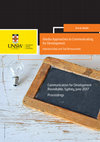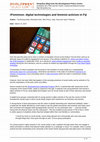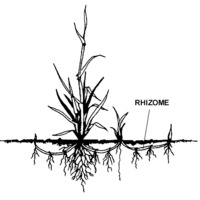Papers by Tait Brimacombe
Chapter 6, in the edited collection - Transformations of Gender in Melanesia - by M. Macintyre & ... more Chapter 6, in the edited collection - Transformations of Gender in Melanesia - by M. Macintyre & C. Spark.
This paper presents an ethnography of contemporary media practices in Vanuatu, with a particular ... more This paper presents an ethnography of contemporary media practices in Vanuatu, with a particular focus on media narratives and debates around gender equality and women’s clothing, exploring how the discourses of kastom, Christianity and ‘modernity’ are being employed and communicated across various media platforms.
The use of community media to promote awareness of gender equality through participatory and entertaining content, and the use of mainstream media to communicate a narrative that reinforces existing gendered power structures are each
explored. In addition, social media platforms are identified as an emerging communication tool through which users can straddle the line between producers and consumers of media content and narratives, and engage in frank debate around the
issue of gender equality.
Gender, Technology and Development , 2013
This article explores gender and information and communication technologies (ICTs) in the context... more This article explores gender and information and communication technologies (ICTs) in the context of development, by analyzing a range of international ICT indices developed to measure broad access to and use of ICTs. This analysis highlights the relatively slow integration of specific gender-focused indicators into such indices, combined with the weak disaggregation of data by sex. The article also discusses a range of gender-specific indices followed by analysis of some more recent holistic measurement frameworks that help to illuminate how gender sensitivity can be practically integrated into broad-based communication for development (C4D) initiatives. The article concludes by considering some of the practical actions that can be taken to promote gender sensitivity at the program or initiative level.
The JBI Database of Systematic Reviews & Implementation Reports, 2013
Background A wide range of contextual and programmatic factors frame, affect and constrain commun... more Background A wide range of contextual and programmatic factors frame, affect and constrain communication for development (C4D) interventions undertaken in fragile or conflict affected states. For the purposes of this review, contextual factors include culture, poverty, different stages of conflict (such as latent, open or post-conflict scenarios), policy, legislation and so on, while programmatic factors include the type of intervention, formative and summative evaluation, project design and management, human and financial resources and so on.
Reports by Tait Brimacombe

In June 2017, a group of researchers from Australian universities and practitioners from differen... more In June 2017, a group of researchers from Australian universities and practitioners from different not-for-profit organisations came together to share knowledge and experience in the study and practice of Communication for Development (C4D). This Roundtable was organised as a side-event to the RDI (Research for Development Impact) Network Conference, held at the University of Sydney on 13th-14th June. The aim was to strengthen the value of C4D research and practice by facilitating connections between practitioners and researchers on C4D-related research projects. The focus of this Roundtable was to review and discuss the different uses of the media in ‘communicating for development’. This specific area of C4D is also known as ‘media for development’. Within this framework, both practitioners and researchers shared their experiences in either using or studying particular media channels or media productions designed to address development issues both in the Global South and in Australia.
This paper presents findings from five case studies of coalitions in the Pacific region. It aims ... more This paper presents findings from five case studies of coalitions in the Pacific region. It aims to address gaps in our understanding of the role played by civil society and coalitions in challenging gendered power structures and promoting women’s leadership and decision-making in the Pacific. This in turn provides insights for better supporting and enabling coalitions.
Four factors emerge from the case studies as influential in the formation and functioning of coalitions.
The report also discusses how the coalitions engage with different dimensions of power, and emerging lessons for coalitions and their supporters.
This three-page brief summarises findings from case studies of five gender-focused coalitions in ... more This three-page brief summarises findings from case studies of five gender-focused coalitions in the Pacific, and discusses the implications for coalitions and their supporters.
It highlights four key factors influencing the formation and functioning of the coalitions: formative events; shared purpose; forms of leadership; and the nature of ownership.
One of the lessons that emerges is the importance of safe spaces in which coalition members and others can discuss and reframe attitudes and beliefs, often by sharing personal stories.

In June 2015 a group of academic researchers from Australian universities and practitioners from ... more In June 2015 a group of academic researchers from Australian universities and practitioners from Australian non-governmental organisations (NGOs) came together to discuss the use of communication for development (C4D) in their present and future work. The seminar was organised by Valentina Baú (University on New South Wales) and Tait Brimacombe (La Trobe University) as a pre-conference to the ACFID (Australian Council for International Development) University Network Conference, held in Melbourne on 4th-5th June. The aim was to provide a platform for international development actors involved or interested in communication for development to share experiences, lessons learned and recommendations that could contribute to an improved practice. With the additional aim of strengthening the value of the practice, the event wanted to facilitate connections between practitioners and researchers on C4D-related research projects.
This report details the proceedings of this event, including participants presentations, projects and topics discussed. A list of Australia-based international development practitioners and researchers is also provided.
ACMC Research and Publications by Tait Brimacombe
The Communication and Complex Emergencies Project is a collaboration between the University of Ad... more The Communication and Complex Emergencies Project is a collaboration between the University of Adelaide’s Applied Communication Collaborative Research Unit (ACCRU) and the Australian Civil-Military Centre (ACMC). The project’s main objectives are to highlight the role of communication, including new and social media, in complex emergencies and in support of humanitarian assistance.
The work focuses on ‘what we know’ and in doing so maps out a broad array of knowledge while focusing on the functions, strengths and limitations associated with various forms of media, from social networking and social media to radio, television, print and video. The work has a number of outputs that are designed to support each other, including:
•Social Networking, Social Media: an Annotated Bibliography
•Social Networking, Social Media: Issues Paper
•Communication and Complex Emergencies: Resource Guide.
The Communication and Complex Emergencies Project is a collaboration between the University of Ad... more The Communication and Complex Emergencies Project is a collaboration between the University of Adelaide’s Applied Communication Collaborative Research Unit (ACCRU) and the Australian Civil-Military Centre (ACMC). The project’s main objectives are to highlight the role of communication, including new and social media, in complex emergencies and in support of humanitarian assistance.
The work focuses on ‘what we know’ and in doing so maps out a broad array of knowledge while focusing on the functions, strengths and limitations associated with various forms of media, from social networking and social media to radio, television, print and video. The work has a number of outputs that are designed to support each other, including:
•Social Networking, Social Media: an Annotated Bibliography
•Social Networking, Social Media: Issues Paper
•Communication and Complex Emergencies: Resource Guide.
Blogs by Tait Brimacombe

Over the past few years we’ve seen a number of examples of how social media in Fiji has been used... more Over the past few years we’ve seen a number of examples of how social media in Fiji has been used as an alternate space for political engagement and dissent. It has offered a platform for citizen journalism during the #FijiCrackdown in September 2016, as a vehicle for youth political engagement and a political campaign strategy during the 2014 elections, and as a vehicle for bottom-up regionalism through the Free West Papua Campaign.
Commentary on these examples has focussed on the evolution of social media as a comparatively democratic space for communication, information and dissent, in the wake of continued restrictions on freedom of expression and a prevailing culture of self-censorship within the nation’s mainstream media institutions.
However, there has been little interrogation of the everyday practices of social media use by activists in Fiji, and the implications of this both online and offline.
Recent research by the Developmental Leadership Program (DLP), in partnership with researchers at the University of the South Pacific, seeks to respond to this gap. It explores how young feminists and women’s rights activists in Fiji are using digital technologies such as social media as part of their advocacy and activist practice.
In-depth focus groups conducted with 22 young women’s rights activists in Fiji over the course of 2016 revealed the myriad ways in which social media shapes their experiences as feminists and activists.










Uploads
Papers by Tait Brimacombe
The use of community media to promote awareness of gender equality through participatory and entertaining content, and the use of mainstream media to communicate a narrative that reinforces existing gendered power structures are each
explored. In addition, social media platforms are identified as an emerging communication tool through which users can straddle the line between producers and consumers of media content and narratives, and engage in frank debate around the
issue of gender equality.
Reports by Tait Brimacombe
Four factors emerge from the case studies as influential in the formation and functioning of coalitions.
The report also discusses how the coalitions engage with different dimensions of power, and emerging lessons for coalitions and their supporters.
It highlights four key factors influencing the formation and functioning of the coalitions: formative events; shared purpose; forms of leadership; and the nature of ownership.
One of the lessons that emerges is the importance of safe spaces in which coalition members and others can discuss and reframe attitudes and beliefs, often by sharing personal stories.
This report details the proceedings of this event, including participants presentations, projects and topics discussed. A list of Australia-based international development practitioners and researchers is also provided.
ACMC Research and Publications by Tait Brimacombe
The work focuses on ‘what we know’ and in doing so maps out a broad array of knowledge while focusing on the functions, strengths and limitations associated with various forms of media, from social networking and social media to radio, television, print and video. The work has a number of outputs that are designed to support each other, including:
•Social Networking, Social Media: an Annotated Bibliography
•Social Networking, Social Media: Issues Paper
•Communication and Complex Emergencies: Resource Guide.
The work focuses on ‘what we know’ and in doing so maps out a broad array of knowledge while focusing on the functions, strengths and limitations associated with various forms of media, from social networking and social media to radio, television, print and video. The work has a number of outputs that are designed to support each other, including:
•Social Networking, Social Media: an Annotated Bibliography
•Social Networking, Social Media: Issues Paper
•Communication and Complex Emergencies: Resource Guide.
Blogs by Tait Brimacombe
Commentary on these examples has focussed on the evolution of social media as a comparatively democratic space for communication, information and dissent, in the wake of continued restrictions on freedom of expression and a prevailing culture of self-censorship within the nation’s mainstream media institutions.
However, there has been little interrogation of the everyday practices of social media use by activists in Fiji, and the implications of this both online and offline.
Recent research by the Developmental Leadership Program (DLP), in partnership with researchers at the University of the South Pacific, seeks to respond to this gap. It explores how young feminists and women’s rights activists in Fiji are using digital technologies such as social media as part of their advocacy and activist practice.
In-depth focus groups conducted with 22 young women’s rights activists in Fiji over the course of 2016 revealed the myriad ways in which social media shapes their experiences as feminists and activists.
The use of community media to promote awareness of gender equality through participatory and entertaining content, and the use of mainstream media to communicate a narrative that reinforces existing gendered power structures are each
explored. In addition, social media platforms are identified as an emerging communication tool through which users can straddle the line between producers and consumers of media content and narratives, and engage in frank debate around the
issue of gender equality.
Four factors emerge from the case studies as influential in the formation and functioning of coalitions.
The report also discusses how the coalitions engage with different dimensions of power, and emerging lessons for coalitions and their supporters.
It highlights four key factors influencing the formation and functioning of the coalitions: formative events; shared purpose; forms of leadership; and the nature of ownership.
One of the lessons that emerges is the importance of safe spaces in which coalition members and others can discuss and reframe attitudes and beliefs, often by sharing personal stories.
This report details the proceedings of this event, including participants presentations, projects and topics discussed. A list of Australia-based international development practitioners and researchers is also provided.
The work focuses on ‘what we know’ and in doing so maps out a broad array of knowledge while focusing on the functions, strengths and limitations associated with various forms of media, from social networking and social media to radio, television, print and video. The work has a number of outputs that are designed to support each other, including:
•Social Networking, Social Media: an Annotated Bibliography
•Social Networking, Social Media: Issues Paper
•Communication and Complex Emergencies: Resource Guide.
The work focuses on ‘what we know’ and in doing so maps out a broad array of knowledge while focusing on the functions, strengths and limitations associated with various forms of media, from social networking and social media to radio, television, print and video. The work has a number of outputs that are designed to support each other, including:
•Social Networking, Social Media: an Annotated Bibliography
•Social Networking, Social Media: Issues Paper
•Communication and Complex Emergencies: Resource Guide.
Commentary on these examples has focussed on the evolution of social media as a comparatively democratic space for communication, information and dissent, in the wake of continued restrictions on freedom of expression and a prevailing culture of self-censorship within the nation’s mainstream media institutions.
However, there has been little interrogation of the everyday practices of social media use by activists in Fiji, and the implications of this both online and offline.
Recent research by the Developmental Leadership Program (DLP), in partnership with researchers at the University of the South Pacific, seeks to respond to this gap. It explores how young feminists and women’s rights activists in Fiji are using digital technologies such as social media as part of their advocacy and activist practice.
In-depth focus groups conducted with 22 young women’s rights activists in Fiji over the course of 2016 revealed the myriad ways in which social media shapes their experiences as feminists and activists.